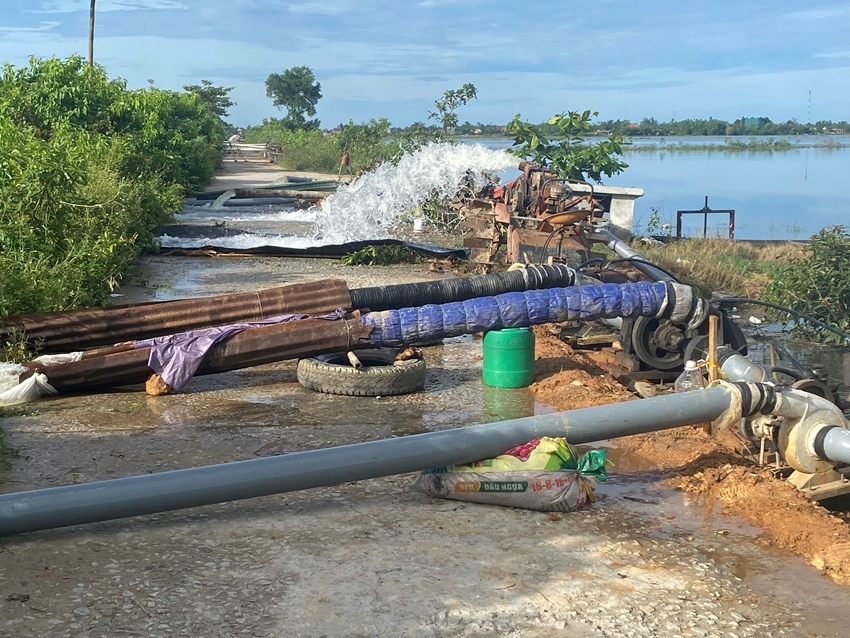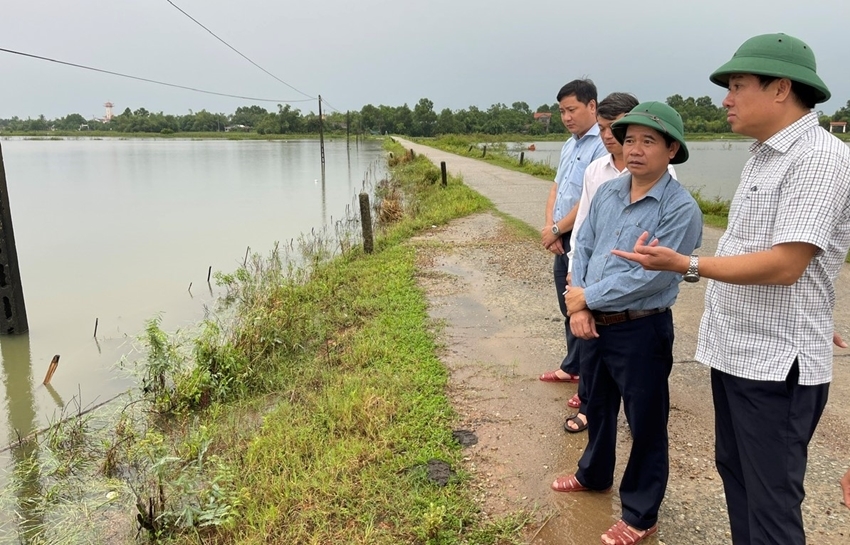 |
| Localities are mobilizing all available resources, machinery, and actively draining water to save rice crops |
22,418 out of 25,126 hectares of rice were submerged
Heavy rain, accompanied by whirlwinds and strong gusts of wind, tore off the roofs of 9 houses of locals in Phu Vang district and Phong Dien town. In Phu Gia commune (Phu Vang district), 8 houses had their roofs blown off; of which, 3 houses suffered 30 - 50% roof damage; 2 houses 50 - 70%; and 3 houses over 70%. In Phong An ward (Phong Dien town), one house, belonging to Ms. Nguyen Thi Ty in Team 6, Dong Lam residential group, Phong An ward, had its roof blown off with 30 - 70% damage.
Immediately after the incident, the People's Committee of Phong An Ward organized forces to temporarily repair Ms. Nguyen Thi Ty's damaged house. The local Party committee, authorities, and organizations also promptly visited, encouraged, and supported Ms. Ty's family with 2 million VND.
The rising floodwaters in the rivers, heavy rain in inland areas combined with high tides, caused flooding in low-lying areas, and coastal plains around lagoons in the districts and towns, including Phong Dien town, Quang Dien, Phu Vang, Huong Tra town, Huong Thuy Town, Phu Xuan district, and Thuan Hoa district.
Across Hue city, 22,418 out of 25,126 hectares of rice were inundated. Localities are mobilizing personnel, machinery, and actively draining water to save the rice crops. The Department of Agriculture and Environment has directed the Sub-Department of Cultivation and Plant Protection and the Agricultural Extension Center to assign technical staff in charge of the areas to coordinate with local authorities to inspect the drainage situation and assess the damage statistics.
According to initial assessments, the estimated area of rice that needs to be re-sown is about 5,000-10,000 hectares out of 25,126 hectares.
These areas are mainly concentrated in low-lying areas where drainage is slow and dependent on tides; for rice in the 10 - 15 day seedling stage, these areas have been submerged for 3 - 4 days. It is likely to take another 2 - 3 days to complete drainage, so these areas are difficult to recover and may be completely destroyed, requiring re-sowing.
Incomplete statistics show that about 1,231 hectares of vegetables and 18.5 hectares of fruit trees were submerged. Localities are continuing to review the submerged areas and damage to report. The Sub-Department of Fisheries, along with many localities, is assessing and developing plans to address damage to aquaculture.
 |
| The leader of Quang Dien district directed efforts to overcome the aftermath of the floods, drain water, and save rice crops |
Mobilizing maximum human resources and machinery for drainage
The entire city has about 120 electric pumping stations serving drainage and combined irrigation for approximately 10,500 hectares of rice. Localities and units have mobilized 507 oil pumps to enhance drainage efforts.
Hue city is currently stocking about 1,000 tons of rice seeds at the Plant and Animal Breeding Joint Stock Company; the National Reserve warehouse to support the recovery of damaged rice areas that cannot be restored. If about 10,000 hectares need to be re-sown, the currently reserved amount of rice seeds will be enough for the entire area.
For submerged rice areas, units and localities are mobilizing maximum human and material resources to clear waterways; operate sluice gates through dikes reasonably; maximize the capacity of existing drainage pumping stations; and add more oil pumping stations for timely drainage to quickly remove water from submerged rice areas, preventing fields from being submerged for many days. In areas where water has receded, broken and overflowing dike sections have been repaired and reinforced to serve drainage efforts.
On June 15, leaders of units and localities continued to direct and mobilize forces along with the people to urgently drain water, and overcome the consequences of the floods. Self-defense militia, disaster response task force, officials, staff, and local residents cleaned up the environment, rapidly restoring transportation routes, essential infrastructure, and production and business activities.
Hue City Power Company also implemented plans to ensure electricity supply for agricultural cooperatives and pumping stations for drainage, serving production. Localities and agricultural cooperatives mobilized materials and personnel to coordinate with Hue Irrigation Exploitation One Member Limited Company to operate reservoirs and drainage sluices through dikes, mobilizing all drainage pumps, and urgently implementing flood control to protect the 2025 Summer-Autumn crop planting area.
Hue City Military Command and Hue City Border Guard Command continue to provide “reinforcements” to the grassroots, coordinating with local Party committees and authorities to support people in overcoming the consequences caused by floods. Hue City Police deployed forces to organize traffic diversions, warn of traffic hazards, prevent people and vehicles from passing through flooded areas, and assist people in recovering after the floods.
Taking advantage of the good weather, units, localities, and locals went to the fields to promptly overcome the damage caused by the floods, especially focusing on draining water and saving rice crops.